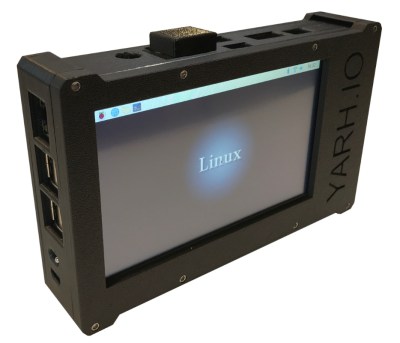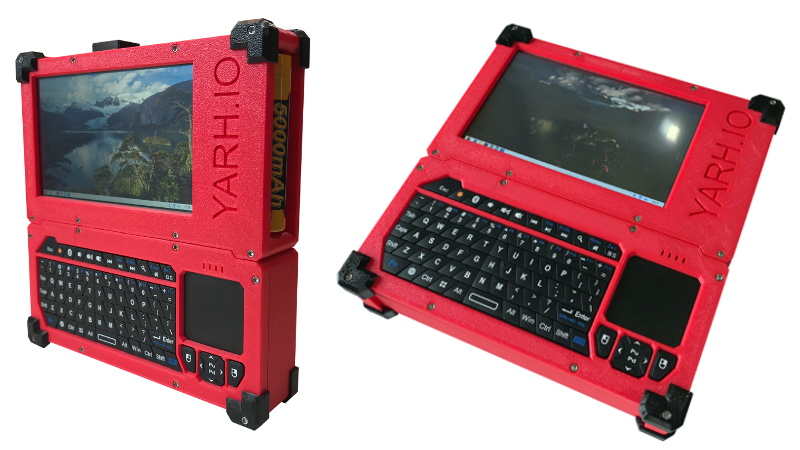Less than a decade ago, building a completely custom portable computer was more or less out of the question. Sure you could have cobbled something together with a Gumstix board and the dinky NTSC/PAL screen pulled from a portable DVD player, but it wouldn’t exactly have been a daily driver. But now we have cheap high definition LCD panels, desktop 3D printers, and of course, the Raspberry Pi.
We’ve seen these elements combined into bespoke personal computing devices too many times to count now, but very few of them can compare to the incredible YARH.IO. It’s been designed from the ground up for easy assembly and customization; you don’t have to worry about getting custom PCBs made or tracking down some piece of unobtanium hardware. Everything inside of the 3D printed enclosure is an off-the-shelf module, needing little more than the occasional scrap of protoboard to tie them all together.

One glance at the rugged design of the YARH.IO, and it’s clear this device wasn’t meant to live on a shelf. Whether it’s getting tossed around the workbench or thrown into a bag on the way to a hacker con, the militarized design of this portable is ready for action. Using appropriately strong materials such as PETG and ABS, we have no doubt the enclosure will survive whatever the on-the-go hacker can throw at it.
But what’s arguably the best feature of the YARH.IO also happens to be the least obvious: the modular design of the enclosure allows you to remove the lower keyboard section and use it as a battery powered Linux tablet (albeit a rather chunky one). Whether the keyboard is attached or not, you still have access to the Pi’s expansion header thanks to a clever pass-through.
Like with the Mil-Plastic that [Jay Doscher] released recently, we know these 3D printed kits will never be as strong as the real military gear they’re emulating. But let’s be realistic, none of us keyboard warriors will be taking them into an actual battlefield anytime soon. What’s more important is that their modular construction allows them to be easily modified for whatever the user’s needs might be. With as far as the state-of-the-art in DIY bespoke computing as come in the last decade, we can’t wait to see what the future holds.
















unubtanium???
hardtofindium
Incorrectspellingium
makeityourselfium
peTROLLeum
This is a beautifully crafted piece of machinery and before any of you trolls try and find something negative to say about this take a moment to think if you have ever created something better, keep that negativity to yourself its unwanted here.
This x100
Though I will say it seems as if his costings seem to have included the price of the 3D printer in the cost of the project, as even if you had a service print the parts I can’t imagine it would cost over 300 CDN to get it printed (unless you used shapeways perhaps…)
A 1kg spool of PLA costs me $20 USD. I’m having a big problem wrapping my head around how the housing for this thing can possibly hit $350 CDN.
Not to mention that small keyboard everyone is throwing at their Pi’s lately. I’m wondering if anyone has tried to type on one for any reasonable length of time, because I have, and it’s not a pleasant experience. When your machine doesn’t have a comfortable interface, it doesn’t matter how slick the setup looks; you just won’t want to use it after awhile.
Let’s try not to confuse useful criticism with negativity for the sake of negativity. This is a great little starting build, but it is far from perfect, and there are issues that would need to be dealt with if it’s going to be a successful product.
But therein lies the beauty… a small keyboard like this is never going to be comfortable to type on and a 60% regular keeb is never going to be that small. And that’s why there’s a modular interface. so you can swap in your interface of preference depending on your circumstance. even swap in a game controller for your retropie sessions ;) (not that i’ve thought about a similar modular interface… much… nope. no siree….)
I use the 2-finger typing method on my EEE PC 701 netbook and HP 95LX palmtop. It’s a compromise but still comfortable in that I’m not suffering when I use it.
Actually, though I’ve occasionally denounced articles about “a Raspberry Pi in an unusual case,” this looks reasonable and practical to me, and I don’t have anything negative to say, thanks.
Just me or is the BOM missing a memory card?
A re-birth of the Speak ‘n Spell?
“But let’s be realistic, none of us keyboard warriors will be taking them into an actual battlefield anytime soon. ”
But let’s be realistic, in this country (USA) the battlefield will be coming to us, soon!
(tongue in cheek)
I like it, but I wonder if he could have ditched that particular keyboard for one that didn’t have a touch pad and used all the space for the keys? The touch pad is especially useless with a touch screen. Bigger keys won’t make this a typing dream but it would be alot more usable than this. I have the keyboard in the picture and hate using it for anything other than really basic input.
im currently working on the 3rd iteration of my own pi tablet. its significantly more behemoth than this one. if im happy with it i might actually publish the source files this time. first iteration was bare bones, stupid, and hard to assemble. second iteration had sound and a better battery system, but both ended up having terrible performance. the audio was kvlt and the battery weak. it also had cooling problems.
third iteration will be better. moving up to a pi4. sound is going to i2s with pre-engineered enclosures. battery system is replaced with a pijuice and a 10ah battery. it also features proper heat management. my biggest issue is the size of my 3d printer which prohibits a monolithic enclosure. so everything is built into a 3 piece subframe with the exterior made from 5 swappable panels. so clean tablet, portable gaming, and cyberdeck would all be options.
On their website (http://yarh.io/shop.html) they have a few prototypes for sale: $630.
Seems a bit salty.
“To support future development there is a limited number of fully functional prototypes available for sale. ”
The price point isn’t intended to compete as a consumer product – it’s intended to allow people to financially support future development. This is fund raising.
Is this design “open source?” I see the stl files for the case and there’s (almost?) enough info in the pics and description to hack one of these together. Tempting! Anyone know what the piece is with the springs and longish arm/clip arrangement?
…also, would a capacitive touch screen be more useful than a resistive? Maybe multi-touch capabilities would be overrated but not necessarily in “tablet mode.” I don’t know much about touchscreens. Would capacitive ones have a controller board with the same form-factor as the XPT2046 board in the pic?
That’s the battery charger guts. The display for the charger is shown on the back side picture.
Thanks, barry99705. I looked up all the parts and I agree with you. The purpose-shaped metal bracket I was also wondering about is from there, too. Other than the 3D printing, the only thing that looks custom is the wiring harness. Next step is to knock out some printed pieces and see how things fit. 😁
I finished it. Check it out here:
https://www.reddit.com/r/cyberDeck/comments/j0cjy0/i_built_a_yarhio_cyberdeck/?utm_source=share&utm_medium=ios_app&utm_name=iossmf